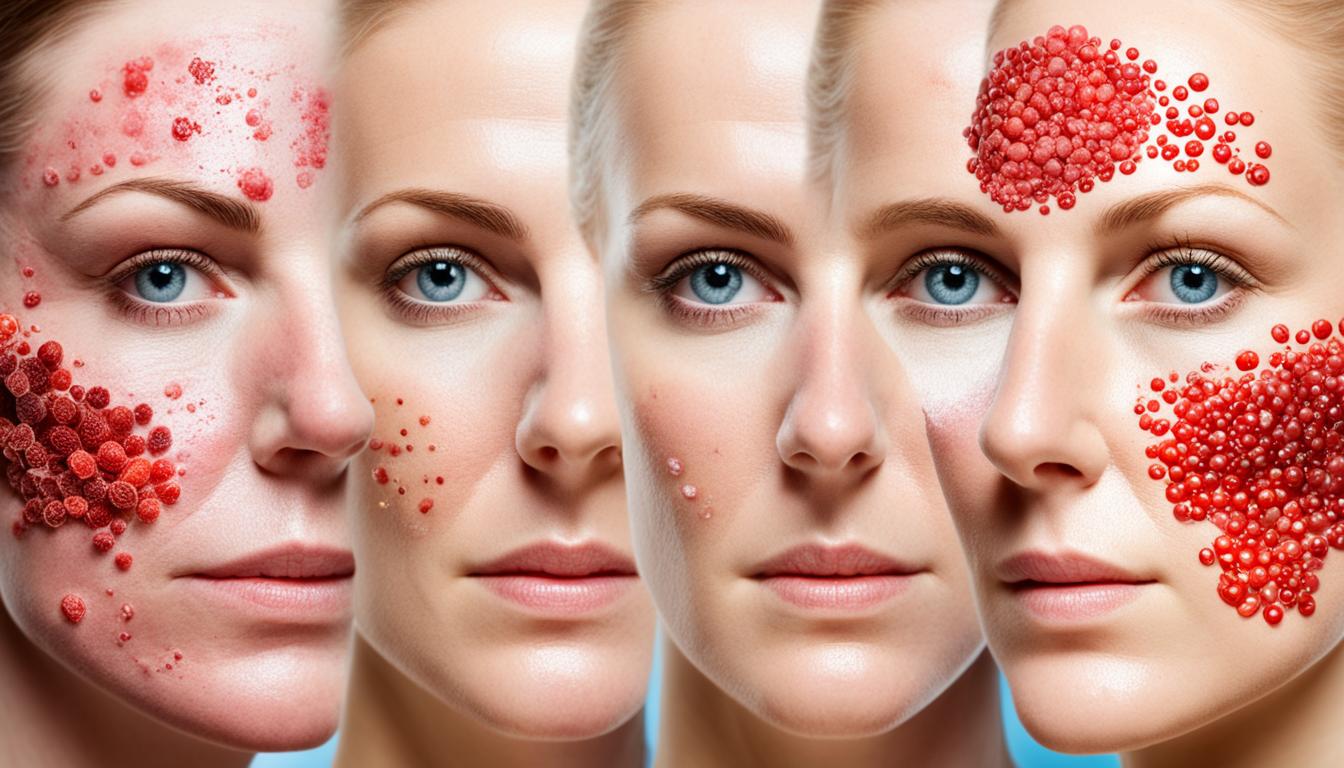Seborrheic dermatitis is a chronic skin disorder. It often comes back and affects areas rich in oil glands. You’ll see red or orange skin patches with gray scales, either dry or oily. It can be itchy and there may be scaly bumps. The most common spots it appears on are the face, chest, scalp, and skin folds.
The exact cause of seborrheic dermatitis isn’t fully known. Yet, some things like higher oil production, change in skin bacteria, and immune system shifts may play a part. Hormonal changes can also make it more likely you’ll get it.
Doctors mainly identify it by how it looks and the symptoms. Sometimes, it could be confused with other skin issues. A close look at the skin and talking about your health history can clear up any confusion.
Usually, doctors use things you put on your skin or use a block for treatment. But not everyone gets better with these. For those people, a ‘stellate ganglion block’ can help. It boosts blood flow and can shake up the immune and endocrine systems, giving these folks some relief.
There’s also the cool possibility of using stem cell therapy for seborrheic dermatitis. Stem cells from different sources can turn into various cells and help control the immune system. Scientists are working on the best ways to use this therapy.
Key Takeaways:
- Seborrheic dermatitis is a chronic inflammatory disorder that affects the skin.
- It is characterized by symptoms such as red-orange patches of skin covered in gray-white scales, dry or greasy skin, itching, and the presence of scaly papules.
- Causes of seborrheic dermatitis include increased sebaceous gland secretions, changes in the cutaneous microflora, and alterations in the immune function of the host.
- Diagnosis is based on the characteristic symptoms and appearance, along with a thorough examination and medical history.
- Treatment options include topical therapies, but stellate ganglion block (SGB) may be effective for patients who are unresponsive to traditional treatments.
- Stem cell therapy is being explored as a potential future treatment option for seborrheic dermatitis.
Causes and Symptoms of Seborrheic Dermatitis
Seborrheic dermatitis shows up as red-orange skin with gray-white scales. It often itches and has scaly papules. This problem likes spots with lots of oil glands, such as the face and scalp.
The exact reason for seborrheic dermatitis is unclear. However, we do know a few things. It might be due to more oil from glands, changes in skin bacteria, and different immune responses. Also, extra oily skin and changes in hormones could play a role.
Common Symptoms and Manifestations
Seborrheic dermatitis can have several signs:
- Red-orange patches of skin
- Gray-white scales covering the affected areas
- Dry or greasy skin
- Itching (in some cases)
- Scaly papules
The signs can range from slight itchiness to bad redness. People may see the problem come and go, with changing symptoms over time.
| Symptoms | Characteristic |
|---|---|
| Red-orange patches of skin | Patches of skin appear red or orange |
| Gray-white scales | Scales form over the affected areas |
| Dry or greasy skin | The skin may become dry or oily |
| Itching | Persistent or occasional itching occurs |
| Scaly papules | Small raised bumps covered in scales |
Diagnosis and Treatment Options for Seborrheic Dermatitis
It’s usually easy to spot seborrheic dermatitis thanks to its unique symptoms and look. But sometimes, it gets confused with conditions like psoriasis or fungal infections. A detailed look at your skin and medical history is key for getting the right diagnosis.
Treating seborrheic dermatitis offers several paths. Doctors often start with products you use on your skin, like special shampoos or creams. These lessen redness, stop itching, and cut down on too much yeast on your skin.
If these more common methods don’t help, there are other ways to try. One method is stellate ganglion blocks (SGBs), injecting a numbing medicine near your neck. This can lower the skin’s swelling and help ease symptoms. Such techniques are still being studied but show potential.
How to treat this depends a lot on how bad it is and what makes you, you. A chat with a skin doctor or another expert is vital. They’ll help find the best plan for you to deal with seborrheic dermatitis.
Overview of Seborrheic Dermatitis Treatment Options
| Treatment | Description |
|---|---|
| Topical Therapies | Includes antifungal shampoos, corticosteroid creams, and antifungal creams. These treatments target the underlying cause and aim to alleviate symptoms. |
| Stellate Ganglion Blocks (SGBs) | An alternative treatment option that involves injecting a local anesthetic into the stellate ganglion to reduce inflammation and relieve symptoms. |
| Individualized Treatment Plans | Based on the severity and individual characteristics of the patient, dermatologists may develop personalized treatment plans that may include a combination of therapies. |
Working with healthcare pros to explore treatments can make a big difference for those with seborrheic dermatitis. With the right care, symptoms can be managed, and life quality can go up.
Stem Cell Therapy for Seborrheic Dermatitis
Stem cell therapy is a new hope for those with seborrheic dermatitis. One key player in this field is the mesenchymal stem cell (MSC). It comes from various places like bone marrow, umbilical cord blood, and more. Scientists find that MSCs can change into different cell types. They also can calm the immune system and lower skin inflammation.
Studies show MSC treatment is safe and works for different diseases. This includes problems like autoimmune issues. The success of these studies opens doors for more research. The goal is to see how stem cell therapy could help with seborrheic dermatitis.
For the dermatology world, stem cell therapy is a big deal. It uses MSCs to address the root problem with seborrheic dermatitis. As we learn more, this treatment might become common. It could be a real help for those fighting this skin condition.

